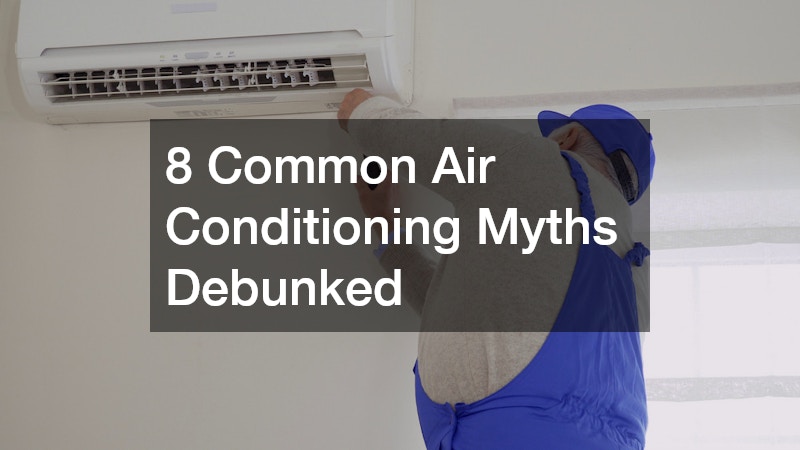Air conditioning plays a vital role in maintaining comfort during the sweltering Australian summer. However, a host of myths still circulate, influencing how people use, maintain and perceive these essential systems.
Misinformation can lead to inefficiencies, increased costs and unnecessary stress. By separating fact from fiction, you can ensure your air conditioning unit operates optimally and economically.
Myth 1: Bigger Units Cool Better & Faster
A widespread belief is that a larger unit will cool a room more effectively. In reality, size does matter—just not in the way most people assume. An oversized unit may cool the room quickly, but it will do so inefficiently. These units tend to cycle on and off too frequently, leading to poor humidity control, higher energy bills and increased wear and tear on components. The key is to select a system based on the size of the space, insulation and usage patterns. Professional assessments can help ensure the right fit.
Myth 2: Lowering the Temperature Cools the Room Faster
It’s tempting to crank the thermostat down to the lowest setting in hopes of rapid cooling, but air conditioning systems don’t work that way. Most units operate at a constant rate regardless of the temperature setting. Lowering the temperature simply makes the unit run longer, not faster. Instead of speeding things up, you may end up overcooling the room and increasing your energy usage unnecessarily. A moderate, comfortable setting is more effective for both cooling and cost-efficiency.
Myth 3: Air Conditioning Is Only for Summer
While most people associate air conditioning with escaping the summer heat, many modern systems offer year-round climate control. Reverse-cycle air conditioners can also heat your home during winter, making them a versatile investment. Ignoring this functionality means missing out on the full value of your system. Using your unit for both heating and cooling can improve comfort throughout the year and reduce the need for additional heating devices.
Myth 4: You Should Turn the Unit Off When You Leave
Conserving energy by turning off your system when leaving the house seems logical, but it can backfire. If you’re away for a short time, turning the unit off can lead to higher energy use when you return, as the system works harder to restore a comfortable temperature. A more efficient approach is to raise the temperature setting or use a programmable thermostat to manage climate conditions in your absence. Smart systems even allow remote control via apps, striking a balance between comfort and energy savings.
Myth 5: Regular Maintenance Isn’t Necessary
Another common myth is that air conditioning systems are “set and forget.” Without regular maintenance, filters become clogged, coils accumulate dust and overall efficiency drops. Over time, neglect can lead to more serious problems and costly repairs. Routine servicing ensures components are clean, refrigerant levels are optimal and any issues are addressed before they escalate. A well-maintained unit not only performs better but also lasts longer, protecting your investment.
Myth 6: Ceiling Fans & Air Conditioning Don’t Mix
Some homeowners avoid using ceiling fans with air conditioning, believing it’s redundant or wasteful. In fact, fans can complement cooling systems effectively. They circulate cool air more evenly throughout the space, allowing the thermostat to be set a few degrees higher without sacrificing comfort. This combined approach can lead to noticeable energy savings, especially during peak usage times. Using both tools in tandem is a smart and economical strategy.
Myth 7: Leaving Doors & Windows Open Helps Ventilation
While ventilation is important, leaving doors and windows open while the air conditioner is running is counterproductive. Doing so lets in hot, humid air, making the system work harder to maintain the desired temperature. Instead of improving airflow, it undermines the system’s efficiency. It’s best to keep the environment as sealed as possible while the unit is operating and use ventilation systems specifically designed for fresh air exchange when necessary.
Myth 8: All Air Conditioning Systems Are the Same
Not all systems are created equal and assuming otherwise can lead to disappointment. Differences in technology, energy efficiency ratings, installation quality and brand reliability all play a part in performance and cost over time. Some units are designed for small spaces, while others cater to larger areas or offer smart home integration. Consulting with a qualified technician can help you choose a system that suits your specific needs, lifestyle and budget.
Relying on Facts for Year-Round Comfort
Air conditioning is an essential part of modern living in Australia, yet persistent myths can lead to higher energy costs, decreased performance and unnecessary repairs. Understanding how these systems actually work empowers homeowners to use them more effectively. From choosing the right size unit to combining it with fans and keeping up with maintenance, each decision affects your comfort and long-term savings.
Don’t let outdated ideas compromise your comfort or your wallet. By debunking these common myths, you can get the most out of your air conditioning system while staying cool, efficient and in control.
.



